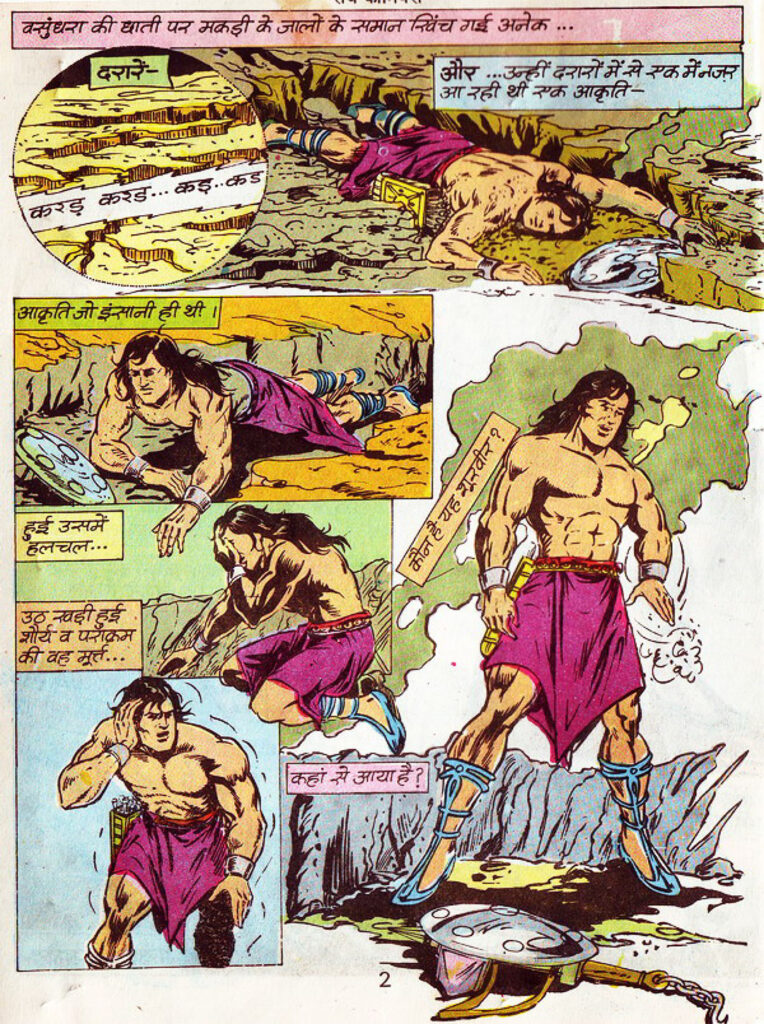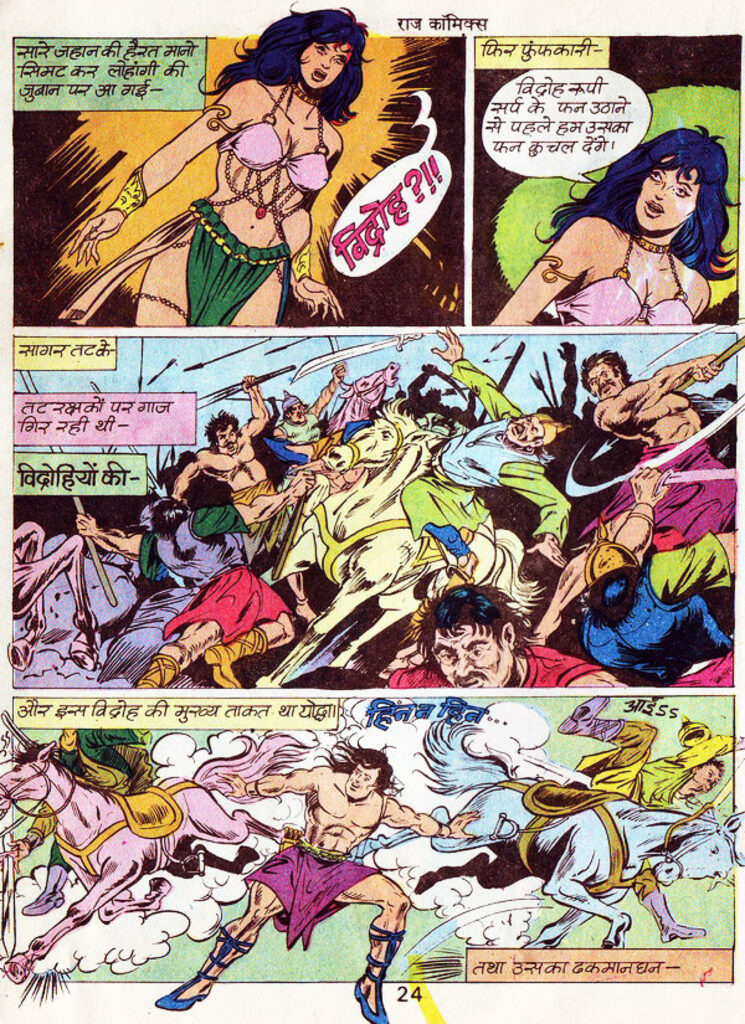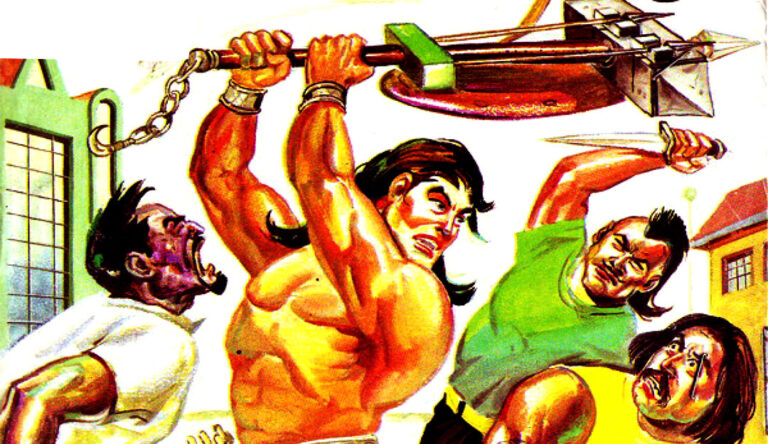The place of Raj Comics in the history of Indian comics is etched in golden letters. There was a time when characters like Nagraj, Super Commando Dhruv, Doga, and Parmanu lived in the hearts and minds of both children and adults. Amid this galaxy of superheroes, Raj Comics introduced a hero in the style of fantasy and sword-and-sorcery who was unique in every sense—the “Yoddha” (Warrior).
Brought to life by writer T.R. Sippy’s pen and artist Vinod Kumar’s brush, this character was far ahead of its time. He carried readers into an unfamiliar world filled with adventure, bravery, and mystery. Today, we’ll dive into and review in detail the first issue of Raj Comics’ number 472, “Yoddha,” which began the saga of this great hero.
The Plot and Its Analysis: A Timeless Epic
The comic begins in a dramatic, mysterious way. A fierce explosion shakes the earth, the ground cracks open, and from within emerges a towering, muscular man in ancient attire. In his hand is a strange multipurpose weapon named “Dhakmandhan.”
This mysterious figure is our hero—the Warrior. His eyes reflect astonishment and confusion as he finds himself in a world completely alien to him. The modern city of Rajnagar is like an impossible puzzle. Skyscrapers, speeding cars, and people in modern clothing make him realize he has been transported into another dimension—far from his own time and world.
Clash of Cultures and the First Encounter
This part of the story beautifully captures the mental state of a “man out of time.” As the Warrior walks the streets of Rajnagar in his ancient garb and towering physique, people stare at him in curiosity and disbelief. Some think he’s a stage actor, while others mock him.
Here, the seeds of the first conflict are planted. Some local thugs notice the priceless jewel embedded in the Warrior’s strange weapon, Dhakmandhan. Believing him to be a simpleton, they attempt to intimidate and rob him.
But that proves to be their biggest mistake. When they attack, they encounter the Warrior’s true might. His fighting style is unlike anything they’ve seen—deadly yet refined. Their knives and blows bounce harmlessly off his steel-like body. With ease, he thrashes them, yet spares their lives.
This first battle establishes three key things:
- The Warrior is immensely powerful and highly skilled in combat.
- He does not tolerate injustice and will fight when necessary.
- He carries a strong moral code—he does not kill without cause.
From the Pages of the Past: The Warrior’s True Identity
The most intriguing part of the story begins when a thug points a pistol at him. At the sight of the metal weapon, the Warrior’s past flashes before his eyes. Through a masterful flashback, the reader is transported to his ancient, barbaric world and shown the origins of this hero.
We learn that the Warrior belonged to a tribal clan in a magical world. He was their protector and symbol of freedom. To defend his people, he fought single-handedly against the massive army of a cruel queen called the “Messenger of Slaves.” Her commander, the dreaded Ballar, sought to capture the Warrior at any cost.

Here, we witness his true courage and the full potential of his miraculous weapon, Dhakmandhan. It could transform into a shield, a mace, a spear, and even shoot poisoned arrows. Artist Vinod Kumar vividly illustrates these transformations, making Dhakmandhan feel like a character in its own right.
Realizing he could not defeat the Warrior in fair combat, Ballar resorts to trickery. The hero is ensnared in a massive net, and both he and his tribe are imprisoned on a ship bound for slavery. But fate intervenes: the ship is attacked by pirates. Amid the chaos, the Warrior breaks free and unleashes havoc, destroying both enemy factions and freeing his people.
This flashback cements him not just as a formidable fighter but also as a liberator and leader whose only goal was to free his people from tyranny. During a decisive battle, as he fights valiantly, a divine beam of light engulfs him, transporting him away from his world—into present-day Rajnagar.
Character Analysis: The Ideal Hero
The Warrior:
The Warrior seems inspired by classic fantasy icons like Robert E. Howard’s Conan the Barbarian or Marvel’s Thor. He speaks little but expresses much through action. He embodies self-respect, duty, and indomitable courage. His confusion with the modern world, balanced with his responsibility to his past, gives great depth to his character. He is the archetypal hero—fighting always for justice.
Dhakmandhan:
More than a weapon, Dhakmandhan is a character of its own. Rarely has Indian comics imagined such a versatile and imaginative weapon. It symbolizes the Warrior’s strength and is central to his strategy. Its design and abilities leave a lasting impression.
The Villains:
While slightly traditional, villains like Ballar and the “Slave Queen” serve their purpose well. Their cruelty and greed highlight the Warrior’s nobility and valor, making his heroism shine even brighter.
Artwork and Presentation
Vinod Kumar’s artwork is one of the comic’s biggest strengths. His style is a hallmark of Raj Comics of the 80s and 90s—dynamic, energetic, and dramatic. The Warrior’s muscular frame, determined expression, and battle agility come alive through his brush.

The panel layout is well thought out, seamlessly shifting between present and past. Bright, bold colors capture the mood perfectly. Though dated by today’s digital standards, the art was more than enough to bring the story’s action to life. Sound effects like “Dhad,” “Dhoom,” and “Aah” heighten the excitement.
Themes and Overall Impact
At its heart, “Yoddha” revolves around timeless themes:
- Justice vs. Injustice: The Warrior always sides with justice against tyranny.
- Freedom: His fight represents not just personal survival but the liberation of his people.
- Isolation and Adaptation: His displacement into the modern world creates empathy and raises the question—how will he adapt?
Conclusion
Overall, “Yoddha” is a classic Raj Comics creation. It’s not just an action-packed fantasy but an unforgettable saga of a hero’s rise, struggle, and moral code. T.R. Sippy’s tight storytelling and Vinod Kumar’s dynamic art have earned it a place among Raj Comics’ most iconic titles.
The comic ends on a cliffhanger. The Warrior stands alone in the modern world—his past left behind, his future uncertain. This powerful beginning leaves readers eager for the next chapter.
For anyone who wants to relive the golden age of Indian comics or loves fantasy epics, “Yoddha” is a must-read. It entertains while reminding us that the fight for justice and heroism transcends time itself.

1 Comment
Pingback: Aakraman – Yoddha #477 Raj Comics Review | comicsbio.com